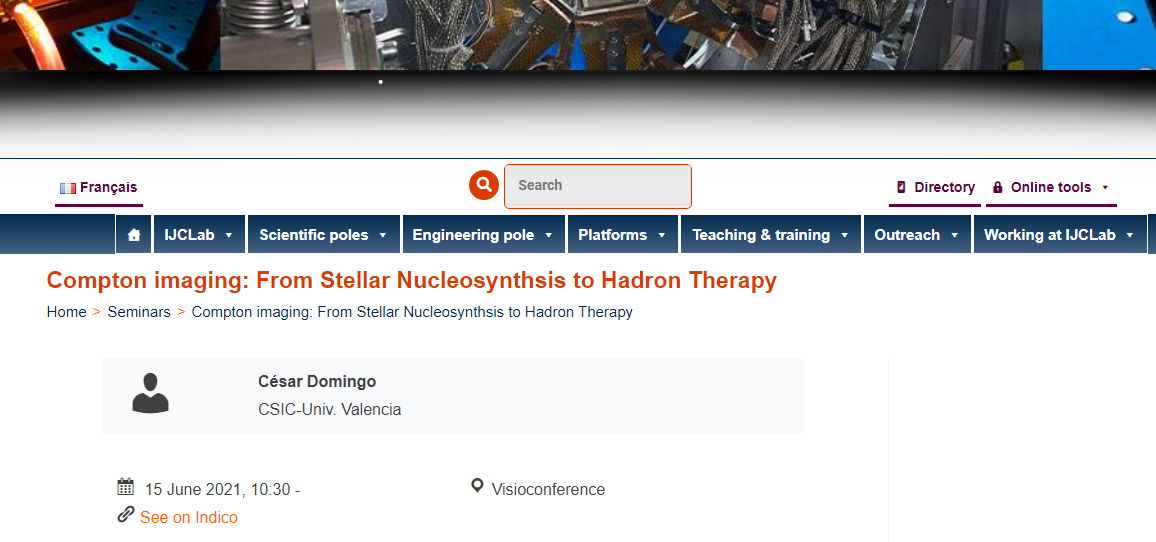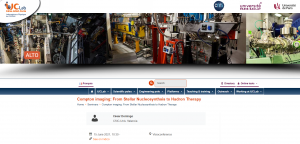News
Compton imaging: From Stellar Nucleosynthesis to Hadron Therapy, invited seminar at IJCLab Orsay (France) by César Domingo Pardo, June 15th, 2021
Compton imaging: From Stellar Nucleosynthesis to Hadron Therapy, invited seminar at IJCLab Orsay (France) by César Domingo Pardo, June 15th, 2021
- Abstract:
see https://indico.ijclab.in2p3.fr/event/7288/
In this talk I will present recent developments in gamma-ray Compton imaging aimed at enhanced sensitivity measurements of stellar neutron-capture reactions utilizing the time-of-flight technique. This work focuses on enabling direct access to neutron-capture experiments on radioactive isotopes of astrophysical interest, like 79Se(n,g), which are of particular relevance for deriving information on the thermal conditions during core He-burning and shell C-burning in massive stars.
Thus far, mainly low-efficiency liquid-scintillation detectors (C6D6) have been used in this type of experiments. However, these detectors are equally sensitive to capture gamma-rays coming from the sample under study, as to background gamma-rays from contaminant neutron reactions in the surroundings. In the framework of the HYMNS-ERC project, we have developed a novel Total-Energy Detector with gamma-ray imaging capability (i-TED) which, by means of the Compton technique, allows us to reject a large portion of neutron-induced background gamma-rays, thereby enhancing significantly the signal-to-background ratio.
The design features of i-TED to cope with tiny capture gamma-ray yields, high neutron-induced backgrounds and hard gamma-ray energies spanning up to 5-6 MeV make it also attractive for medical applications, such as ion-range monitoring in hadron-therapy treatments. We have also explored this possibility and a short summary on the expected performance based on a recent MC study will be presented. In this respect, first experimental tests to use i-TED simultaneously as Compton imager and Positron-Emission Tomograph will be reported. The latter measurements were carried out at the 20 MeV proton cyclotron of CNA-Seville. Finally, a short outlook on the next steps of i-TED in the field of nuclear astrophysics experiments and societal applications will be given.
Biography of the speaker:
César Domingo studied physics at the University of Valencia (Spain) and at the University of Mainz (Germany). His PhD Thesis focused on the measurement of neutron capture reactions of astrophysical interest using the time-of-flight technique at CERN n_TOF (Geneva). He did postdoctoral stays at the Nuclear Astrophysics Group of FZK-Karlsruhe and at GSI-Darmstadt, where he was involved in the AGATA project. In 2011 he got a tenure track position (Ramón y Cajal) at IFIC (CSIC-Univ. Valencia), where he initiated the BRIKEN project devoted to beta-delayed neutron-emission measurements at RIKEN (Japan). In 2016 he was awarded an ERC-Consolidator Grant for the project HYMNS: High sensitivitY Measurements of key stellar Nucleo-Synthesis reactions. In the framework of this project his team is developing an advanced radiation detection system with gamma-ray imaging capability, so-called i-TED (https://arxiv.org/abs/1401.2083), for enhancing the detection sensitivity in neutron capture cross section measurements via the TOF technique. More info at https://hymnserc.ific.uv.es/.
Zoom link:
https://ijclab.zoom.us/j/97240320194?pwd=NFZGQXU2a2J4VmtNUCtHRWtrR1VLQT09
ID meeting: 972 4032 0194

